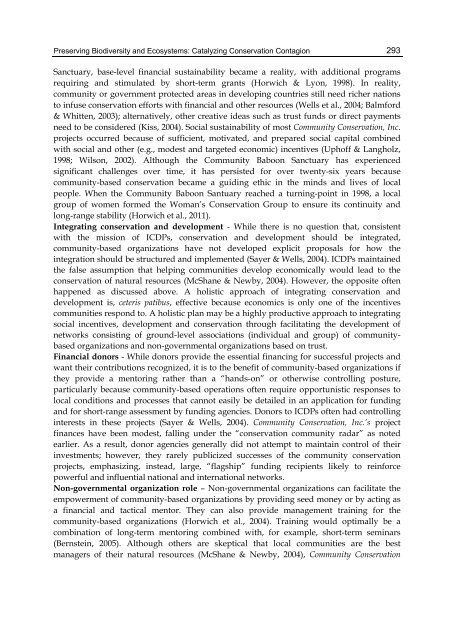DEFORESTATION AROUND THE WORLD - India Environment Portal
DEFORESTATION AROUND THE WORLD - India Environment Portal
DEFORESTATION AROUND THE WORLD - India Environment Portal
You also want an ePaper? Increase the reach of your titles
YUMPU automatically turns print PDFs into web optimized ePapers that Google loves.
Preserving Biodiversity and Ecosystems: Catalyzing Conservation Contagion<br />
Sanctuary, base-level financial sustainability became a reality, with additional programs<br />
requiring and stimulated by short-term grants (Horwich & Lyon, 1998). In reality,<br />
community or government protected areas in developing countries still need richer nations<br />
to infuse conservation efforts with financial and other resources (Wells et al., 2004; Balmford<br />
& Whitten, 2003); alternatively, other creative ideas such as trust funds or direct payments<br />
need to be considered (Kiss, 2004). Social sustainability of most Community Conservation, Inc.<br />
projects occurred because of sufficient, motivated, and prepared social capital combined<br />
with social and other (e.g., modest and targeted economic) incentives (Uphoff & Langholz,<br />
1998; Wilson, 2002). Although the Community Baboon Sanctuary has experienced<br />
significant challenges over time, it has persisted for over twenty-six years because<br />
community-based conservation became a guiding ethic in the minds and lives of local<br />
people. When the Community Baboon Santuary reached a turning-point in 1998, a local<br />
group of women formed the Woman’s Conservation Group to ensure its continuity and<br />
long-range stability (Horwich et al., 2011).<br />
Integrating conservation and development - While there is no question that, consistent<br />
with the mission of ICDPs, conservation and development should be integrated,<br />
community-based organizations have not developed explicit proposals for how the<br />
integration should be structured and implemented (Sayer & Wells, 2004). ICDPs maintained<br />
the false assumption that helping communities develop economically would lead to the<br />
conservation of natural resources (McShane & Newby, 2004). However, the opposite often<br />
happened as discussed above. A holistic approach of integrating conservation and<br />
development is, ceteris patibus, effective because economics is only one of the incentives<br />
communities respond to. A holistic plan may be a highly productive approach to integrating<br />
social incentives, development and conservation through facilitating the development of<br />
networks consisting of ground-level associations (individual and group) of communitybased<br />
organizations and non-governmental organizations based on trust.<br />
Financial donors - While donors provide the essential financing for successful projects and<br />
want their contributions recognized, it is to the benefit of community-based organizations if<br />
they provide a mentoring rather than a “hands-on” or otherwise controlling posture,<br />
particularly because community-based operations often require opportunistic responses to<br />
local conditions and processes that cannot easily be detailed in an application for funding<br />
and for short-range assessment by funding agencies. Donors to ICDPs often had controlling<br />
interests in these projects (Sayer & Wells, 2004). Community Conservation, Inc.’s project<br />
finances have been modest, falling under the “conservation community radar” as noted<br />
earlier. As a result, donor agencies generally did not attempt to maintain control of their<br />
investments; however, they rarely publicized successes of the community conservation<br />
projects, emphasizing, instead, large, “flagship” funding recipients likely to reinforce<br />
powerful and influential national and international networks.<br />
Non-governmental organization role – Non-governmental organizations can facilitate the<br />
empowerment of community-based organizations by providing seed money or by acting as<br />
a financial and tactical mentor. They can also provide management training for the<br />
community-based organizations (Horwich et al., 2004). Training would optimally be a<br />
combination of long-term mentoring combined with, for example, short-term seminars<br />
(Bernstein, 2005). Although others are skeptical that local communities are the best<br />
managers of their natural resources (McShane & Newby, 2004), Community Conservation<br />
293

















